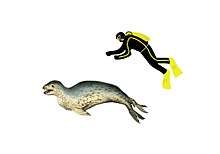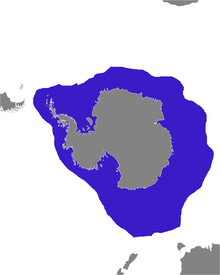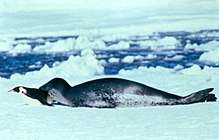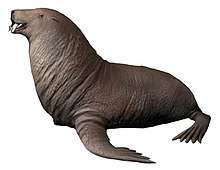Leopard seal
The leopard seal (Hydrurga leptonyx), also referred to as the sea leopard[3], is the second largest species of seal in the Antarctic (after the southern elephant seal). Its only natural predator is the killer whale.[4] It feeds on a wide range of prey including cephalopods, other pinnipeds, krill, birds and fish. It is the only species in the genus Hydrurga. Its closest relatives are the Ross seal, the crabeater seal and the Weddell seal, which together are known as the tribe of Lobodontini seals.[5][6] The name hydrurga means "water worker" and leptonyx is the Greek for "small clawed".
| Leopard seal[1] | |
|---|---|
_04.jpg) | |
| At the Antarctic Sound, near Brown Bluff, Tabarin Peninsula | |
 | |
| Size compared to a 6ft human | |
| Scientific classification | |
| Kingdom: | Animalia |
| Phylum: | Chordata |
| Class: | Mammalia |
| Order: | Carnivora |
| Clade: | Pinnipediformes |
| Clade: | Pinnipedia |
| Family: | Phocidae |
| Subfamily: | Monachinae |
| Tribe: | Lobodontini |
| Genus: | Hydrurga Gistel, 1848 |
| Species: | H. leptonyx |
| Binomial name | |
| Hydrurga leptonyx (Blainville, 1820) | |
 | |
| Hydrurga leptonyx range map | |
| Synonyms | |
| |
Taxonomy
French zoologist Henri Marie Ducrotay de Blainville described the leopard seal in 1820.
Description

The leopard seal has a distinctively long and muscular body shape, when compared to other seals. This species of seal is known for its massive reptilian-like head and jaws that allow it to be one of the top predators in its environment. A notable key feature of leopard seals is its counter-shaded coat. A counter-shaded coat is when the dorsal side of the coat is darker than ventral side. Leopard seals have a silver to dark gray blended coat that makes up its distinctive "leopard" coloration with a spotted pattern, whereas the ventral side of the coat is paler in color—ranging from white to light gray.[7] Females are slightly larger than the males.[8] The overall length of this seal is 2.4–3.5 m (7.9–11.5 ft) and weight is from 200 to 600 kilograms (440 to 1,320 lb). They are about the same length as the northern walrus, but usually less than half the weight.[9][10]
Another notable characteristic of leopard seals are their short, clear whiskers that are used to sense their environment. Leopard seals have an enormous mouth relative to their body size.[7] The front teeth are sharp like those of other carnivores, but their molars lock together in a way that allows them to sieve krill from the water, in the manner of the crabeater seal. Since leopard seals are "true" seals, they do not have external pinnae, or ears, but they do have an internal ear canal that leads to an external opening.[11] Their hearing in air is similar to that of a human, but scientists have noted that leopard seals use their ears in conjunction with their whiskers to track prey under water.[11]
Distribution
Leopard seals are pagophilic ("ice-loving") seals, which primarily inhabit the Antarctic pack ice between 50˚S and 80˚S. Sightings of vagrant leopard seals have been recorded on the coasts of Australia, New Zealand (where individuals have been seen even on the foreshores of major cities such as Auckland[12] and Dunedin[13]), South America, and South Africa.[11] In August 2018, an individual was sighted at Geraldton, on the west coast of Australia. Higher densities of leopard seals are seen in the Western Antarctic than in other regions.[14][15]
Most leopard seals remain within the pack ice throughout the year and remain solitary during most of their lives with the exception of a mother and her newborn pup.[16][11][17] These matrilineal groups can move further north in the austral winter to sub-antarctic islands and the coastlines of the southern continents to provide care for their pups.[11] While solitary animals may appear in areas of lower latitudes, females rarely breed there. Some researchers believe this is due to safety concerns for the pups.[18] Lone male leopard seals hunt other marine mammals and penguins in the pack ice of antarctic waters. The estimated population of this species ranges from 220,000 to 440,000 individuals, which puts leopard seals at "least concern".[11] Although there is an abundance of leopard seals in the Antarctic, they are difficult to survey by traditional visual techniques[19] because they spend long periods of time vocalizing under the water during the austral spring and summer, when visual surveys are carried out. The trait of vocalizing underwater for long periods means they can be the subject of acoustic surveys, allowing researchers to gather most of what is known about them.[20]
Behavior
_05.jpg)
Acoustic behavior
Leopard seals are very vocal underwater during the austral summer.[20] The male seals produce loud calls (153 to 177 dB re 1 μPa at 1 m) for many hours each day.[21] While singing the seal hangs upside down and rocks from side to side under the water. Their back is bent, the neck and cranial thoracic region (the chest) is inflated and as they call their chest pulses. The male calls can be split into two categories: vocalizing and silencing, in which vocalizing is when they are making noises underwater, and silencing noted as the breathing period at the air surface.[22] Adult male leopard seals have only a few stylized calls, some are like bird or cricket-like trills yet others are low haunting moans.[23] However, scientists have identified five distinctive sounds that male leopard seals make, which include: the high double trill, medium single trill, low descending trill, low double trill, and a hoot with a single low trill. These cadence of calls are believed to be a part of a long range acoustic display for territorial purposes, or the attraction of a potential mate.[22] The leopard seals have age-related differences in their calling patterns, just like birds. Where the younger male seals have many different types of variable calls – the adult male seals have only a few, highly stylized calls.[24] Each male leopard seal produces these individual calls, and can arrange their few call types into individually distinctive sequences (or songs).[25] The acoustic behavior of the leopard seal is believed to be linked to their breeding behaviour. In male seals, vocalizing coincides with the timing of their breeding season, which falls between November and the first week of January; captive female seals vocalize when they have elevated reproductive hormones.[23] Conversely, a female leopard seal can attribute calls to their environment as well; however, usually it is to gain the attention of a pup, after getting back from a forage for food.
Breeding habits
.jpg)
Since leopard seals live in an area difficult for humans to survive in, not much is known on their reproduction and breeding habits. However, it is known that their breeding system is polygynous, meaning that males mate with multiple females during the mating period. A sexually active female (ages 3–7) can give birth to a single pup during the summer on the floating ice floes of the Antarctic pack ice, with a sexually active male (ages 6–7). Mating occurs from December to January, shortly after the pups are weaned when the female seal is in estrus.[26] In preparation for the pups, the females dig a circular hole in the ice as a home for the pup. A newborn pup weighs around 66 pounds and are usually with their mother for a month, before they are weaned off. The male leopard seal does not participate in taking care of the pup, and goes back to its solitary lifestyle after the breeding season.[11] Most leopard seal breeding is on pack ice.[27]
Five research voyages were made to Antarctica in 1985, 1987 and 1997–1999 to look at leopard seals.[27] They sighted seal pups from the beginning of November to the end of December, and noticed that there was about one pup for every three adults, and they also noticed that most of the adults were staying away from other adults during this season, and when they were seen in groups they showed no sign of interaction.[28] Leopard seal pups mortality rate within the first year is close to 25%.[29]
Vocalization is thought to be important in breeding, since males are much more vocal around this time. Mating takes place in the water, and then the male leaves the female to care for the pup, which the female gives birth to after an average gestation period of 274 days.[26]
Research shows that on average, the aerobic dive limit for juvenile seals is around 7 minutes, which means that during the winter months juvenile leopard seals do not eat krill, which is a major part of older seals' diets, since krill is found deeper during this time.[30] This might occasionally lead to co-operative hunting. Co-operative hunting of leopard seals on Antarctic fur seal pups has been witnessed, which could be a mother helping her older pup, or could also be female-male couple interactions, to increase their hunting productivity.[31]
Foraging behavior

The only natural predators of leopard seals is the killer whale and possibly the elephant seal.[4] Its canine teeth are 2.5 cm (1 in).[32] It feeds on a wide variety of creatures. Young leopard seals will usually eat mostly krill, squid and fish. Adult seals probably switch from krill to more substantial prey, including king, Adélie, rockhopper, gentoo, emperor and chinstrap penguins, and less frequently, Weddell, crabeater, Ross, and young southern elephant seals. Leopard seals are also known to take fur seal pups.[33]
Around the sub-Antarctic island of South Georgia, the Antarctic fur seal (Arctocephalus gazella) is the main prey. Other prey include penguins and fish. Antarctic krill (Euphausia superba), southern elephant seal (Mirounga leonina) pups and seabirds other than penguins have also been taken as prey.[34]
When hunting penguins, the leopard seal patrols the waters near the edges of the ice, almost completely submerged, waiting for the birds to enter the ocean. It kills the swimming bird by grabbing the feet, then shaking the penguin vigorously and beating its body against the surface of the water repeatedly until the penguin is dead. Previous reports stating the leopard seal skins its prey before feeding have been found to be incorrect. Lacking the teeth necessary to slice its prey into manageable pieces, it flails its prey from side to side tearing and ripping it into smaller pieces. Krill meanwhile, is eaten by suction, and strained through the seal's teeth, allowing leopard seals to switch to different feeding styles. Such generalization and adaptations may be responsible for the seal's success in the challenging Antarctic ecosystem.[35]
Physiology and research
Leopard seals' heads and front flippers are extremely large in comparison to other phocids. Their large front flippers are used to steer themselves through the water column making them extremely agile while hunting. They use their front flippers similarly to sea lions (otariids)[36] and leopard seal females are larger than males.[37] They are covered in a thick layer of blubber that helps to keep them warm while in the cold temperatures of the Antarctic. This layer of blubber also helps to streamline their body making them more hydrodynamic. This is essential when hunting small prey items such as penguins because speed is necessary. Scientists take blubber thickness, girth, weight, and length measurements of leopard seals to learn about their average weight, health, and population as a whole.[38] These measurements are then used to calculate their energetics which is the amount of energy and food it takes for them to survive as a species. They also have incredible diving capabilities. This information can be obtained by scientists by attaching transmitters to the seals after they are tranquilized on the ice. These devices are called satellite-linked time depth recorders (SLDRs) and time-depth recorders (TDRs). Scientists attach this device usually to the head of the animal and it records depth, bottom time, total dive time, date and time, surface time, haul out time, pitch and roll, and total number of dives.[39] This information is sent to a satellite where scientists from anywhere in the world can collect the data. This is how we are currently learning so much about leopard seals diet and foraging habits. With this information we are able to calculate and better understand their diving physiology. They are primarily shallow divers but they do dive deeper than 80 meters in search for food.[39] They are able to complete these dives by collapsing their lungs and re-inflating them at the surface. This is possible by increasing surfactant which coats the alveoli in the lungs for re-inflation. They also have a reinforced trachea to prevent collapse at great depth pressures.[40]
Relationships with humans
Leopard seals are apex predators presenting a potential risk to humans. However, attacks on humans are rare. Most human perceptions of leopard seals are shaped by historic encounters between humans and leopard seals, that have occurred since the Heroic Age of Antarctic exploration.[41]
Negative interactions with humans
Examples of aggressive behaviour, stalking and attacks have been documented.[42] Notable incidents include:
- A large leopard seal attacked Thomas Orde-Lees (1877–1958), a member of Sir Ernest Shackleton's Imperial Trans-Antarctic Expedition of 1914–1917, when the expedition was camping on the sea ice.[43] The "sea leopard", about 12 ft (3.7 m) long and 1,100 lb (500 kg), chased Orde-Lees on the ice. He was saved only when another member of the expedition, Frank Wild, shot the animal.[44]
- In 1985, Scottish explorer Gareth Wood was bitten twice on the leg when a leopard seal tried to drag him off the ice and into the sea. His companions managed to save him by repeatedly kicking the animal in the head with the spiked crampons on their boots.[43][42]
Fatal Leopard Seal human interactions
- In 2003, biologist Kirsty Brown of the British Antarctic Survey was killed by a leopard seal while snorkeling in Antarctica. This was the first recorded human fatality from a leopard seal.[43][42] Brown was part of a team of four researchers taking part in an underwater survey at South Cove near the U.K.'s Rothera Research Station. Brown and another researcher, Richard Burt, were snorkeling in the water. Burt was snorkeling 15 meters away when the team heard a scream and saw Brown disappear into the water. She was quickly rescued by her team but they were unfortunately unable to resuscitate her. It was later revealed that the seal had held her underwater for six minutes at a depth of up to 70m. She suffered a total of 45 separate injuries most of which were concentrated around her head and neck. As she was snorkeling at the time she may have seen the seal approaching her.
In a report read at the inquiry into Brown's death, Professor Ian Boyd from St. Andrews University stated that the seal may have mistaken her for a fur seal or may have been frightened by her presence and attacked in defense. Professor Boyd said that Leopard Seal attacks on humans were extremely rare but warned that they may potentially become more common due to increased human presence in Antarctica. The coroner recorded a verdict of an accidental death caused by drowning due to a leopard seal attack.[45]
Interactions with human property
Leopard seals have shown a predilection for attacking the black, torpedo-shaped pontoons of rigid inflatable boats, leading researchers to equip their craft with special protective guards to prevent them from being punctured.[42][46]
Positive interactions with humans
Paul Nicklen, a National Geographic magazine photographer, captured pictures of a leopard seal bringing live, injured, and then dead penguins to him, possibly in an attempt to teach the photographer how to hunt.[47]
Conservation
From a conservation standpoint, the only known predators of the leopard seals are killer whales and sharks. Because of their limited subpolar distribution in the Antarctic, they may be at risk as polar ice caps diminish with global warming. In the wild, leopard seals can live up to 26 years old.[48] Leopard seal hunting is regulated by the Antarctic Treaty and the Convention for the Conservation of Antarctic Seals (CCAS).[29]
See also
Notes and references
- Wilson, Don E.; Seeder, Dee Ann M., eds. (2005). "Species: Hydrurga leptonyx". Mammal species of the world : a taxonomic and geographic reference (3rd ed.). Baltimore: Johns Hopkins University Press. ISBN 978-0-8018-8221-0.
- Hückstädt, L. (2015). Hydrurga leptonyx. The IUCN Red List of Threatened Species doi:10.2305/IUCN.UK.2015-4.RLTS.T10340A45226422.en
- "Leopard seal". Encyclopedia Britannica. 1998.
- "Leopard seals". Australian Antarctic Division. Retrieved 14 August 2017.
- Wilson, Don E.; Reeder, DeeAnn M., eds. (2005). "Family: Phocidae". Mammal species of the world : a taxonomic and geographic reference (3rd ed.). Baltimore: Johns Hopkins University Press. ISBN 978-0-8018-8221-0.
- Berta, Annalisa (2009). "Pinnipedia: Overview". In Perrin, W. F.; Würsig, B.; Thewissen, J. G. M. (eds.). Encyclopedia of Marine Mammals (2nd ed.). Academic Press. pp. 878–85. ISBN 978-0-12-373553-9.
- "Marine Species Identification Portal : Leopard seal - Hydrurga leptonyx". species-identification.org. Retrieved 2018-03-19.
- Tunstall, T. "Hydrurga leptonyx". Animal Diversity Web. University of Michigan Museum of Zoology. Retrieved 2009-04-27.
- Nowak, Ronald M (2003). Walker's Marine Mammals of the World. Johns Hopkins University Press: Baltimore, MD.
- Leopard Seals, Hydrurga leptonyx. marinebio.org
- "Leopard seal | TravelWild Expeditions". TravelWild Expeditions. Retrieved 2018-04-18.
- "Leopard seal". www.doc.govt.nz. Retrieved 2020-02-24.
- MacLean, Hamish (2019-01-19). "Leopard seal sightings in New Zealand on the rise". Otago Daily Times Online News. Retrieved 2020-02-24.
- Southwell, C.; Bengtson, J.; Bester, M.; Schytte Blix, A.; Bornemann, H.; Boveng, P.; Cameron, M.; Forcada, J.; Laake, J.; Nordøy, E.; Plötz, J.; Rogers, T.; Southwell, D.; Steinhage, D.; Stewart, B.S.; Trathan, P (2012). "A review of data on abundance, trends in abundance, habitat use and diet of ice-breeding seals in the Southern Ocean". CCAMLR Science. 19: 1–26.
- Forcada, J.; Trathan, P.; Boveng, Boyd; I., Burns; J., Costa; D., Fedak; M., Rogers; T., Southwell, C. (2012). "Responses of Antarctic pack-ice seals to environmental change and increasing krill fishing". Biological Conservation. 149 (1): 40–50. doi:10.1016/j.biocon.2012.02.002.CS1 maint: multiple names: authors list (link)
- Rogers, T.L.; Hogg, C. & Irvine, A. (2005). "Spatial movement of adult leopard seals (Hydrurga leptonyx) in Prydz Bay, Eastern Antarctica". Polar Biology. 28 (6): 456–463. doi:10.1007/s00300-004-0703-4.
- Meade, J.; Ciaglia, M.B.; Slip, D.J.; Negrete, J.; Márquez M.E.I., Rogers, T. (2015). "Spatial patterns in activity of leopard seals Hydrurga leptonyx in relation to sea ice". Marine Ecology Progress Series. 521: 265–275. Bibcode:2015MEPS..521..265M. doi:10.3354/meps11120.CS1 maint: multiple names: authors list (link)
- Taylor, Margot (2017-09-27). "Odds against St Kilda leopard seal pup". Otago Daily Times. Retrieved 2020-07-25.
- Southwell, C.; Paxton, C.; Borchers, D.; Boveng, P. Rogers, T. & de la Mare, W. (2008). "Uncommon or cryptic? Challenges in estimating leopard seal abundance by conventional but state-of-the-art methods". Deep-Sea Research Part I: Oceanographic Research Papers. 55 (4): 519–531. Bibcode:2008DSRI...55..519S. doi:10.1016/j.dsr.2008.01.005.CS1 maint: multiple names: authors list (link)
- Rogers TL, Ciaglia MB, Klinck H, Southwell C (2013). "Density Can Be Misleading for Low-Density Species: Benefits of Passive Acoustic Monitoring". PLOS ONE. 8 (1): e52542. Bibcode:2013PLoSO...852542R. doi:10.1371/journal.pone.0052542. PMC 3541380. PMID 23326339.
- Rogers TL (2014). "Source levels of the underwater calls of a male leopard seal". The Journal of the Acoustical Society of America. 136 (4): 1495–1498. Bibcode:2014ASAJ..136.1495R. doi:10.1121/1.4895685. PMID 25324053.
- Rogers, Tracey L.; Cato, Douglas H. (2002). "Individual Variation in the Acoustic Behaviour of the Adult Male Leopard Seal, Hydrurga leptonyx". Behaviour. 139 (10): 1267–1286. doi:10.1163/156853902321104154. JSTOR 4535987.
- Rogers, T. L.; Cato, D. H. & Bryden, M. M. (1996). "Behavioral significance of underwater vocalizations of captive leopard seals, Hydrurga leptonyx". Marine Mammal Science. 12 (3): 414–427. doi:10.1111/j.1748-7692.1996.tb00593.x.
- Rogers, T. L (2007). "Age-related differences in the acoustic characteristics of male leopard seals, Hydrurga leptonyx". The Journal of the Acoustical Society of America. 122 (1): 596–605. Bibcode:2007ASAJ..122..596R. doi:10.1121/1.2736976. PMID 17614516.
- Rogers, Tracey L.; Cato, Douglas H. (2002). "Individual Variation in the Acoustic Behaviour of the Adult Male Leopard Seal, Hydrurga leptonyx". Behaviour. 139 (10): 1267–1286. doi:10.1163/156853902321104154. JSTOR 4535987.
- "Reproduction - Encyclopedia of Life". Encyclopedia of Life. Retrieved 2018-05-15.
- Southwell, Colin; Kerry, Knowles; Ensor, Paul; Woehler, Eric J.; Rogers, Tracey (2003). "The timing of pupping by pack-ice seals in East Antarctica". Polar Biology. 26 (10): 648–652. doi:10.1007/s00300-003-0534-8.
- Borsa, Philippe (1990). "Seasonal occurrence of the leopard seal, Hydrurga leptonyx, in the Kerguelen Islands". Canadian Journal of Zoology. 68 (2): 405–408. doi:10.1139/z90-059.
- Administrator. "Leopard Seal". www.pinnipeds.org. Retrieved 2018-06-04.
- Kuhn, Carey E.; McDonald, Birgitte I.; Shaffer, Scott A.; Barnes, Julie; Crocker, Daniel E.; Burns, Jennifer; Costa, Daniel P. (2005). "Diving physiology and winter foraging behavior of a juvenile leopard seal (Hydrurga leptonyx)". Polar Biology. 29 (4): 303–307. doi:10.1007/s00300-005-0053-x.
- Hiruki, Lisa M.; Schwartz, Michael K.; Boveng, Peter L. (1999). "Hunting and social behaviour of leopard seals (Hydrurga leptonyx) at Seal Island, South Shetland Islands, Antarctica". Journal of Zoology. 249 (1): 97–109. doi:10.1111/j.1469-7998.1999.tb01063.x.
- Kindersley, Dorling (2005) [2001]. Animal. New York City: DK Publishing. ISBN 978-0-7894-7764-4.
- "POV: Why Are Leopard Seals Eating Fur Seal Pups?". video.nationalgeographic.com. Retrieved 2015-08-08.
- Walker, T.R.; Boyd, I.L.; Mccafferty, D.J.; Huin, N.; Taylor, R.I.; Reid, K. (1998). "Seasonal occurrence and diet of leopard seals (Hydrurga leptonyx) at Bird Island, South Georgia". Antarctic Science. 10 (1): 75–81. Bibcode:1998AntSc..10...75W. doi:10.1017/S0954102098000108.
- Yong, Ed (2012). "Leopard seals suck up krill like whales". Nature. doi:10.1038/nature.2012.11672.
- "Leopard Seals". NOAA Fisheries National Oceanic and Atmospheric Administration Alaska Fisheries Science Center.
- "Leopard Seals, Hydrurga leptonyx". Marine Bio.
- Krause, Douglas J.; Hinke, Jefferson T.; Perryman, Wayne L.; Goebel, Michael E.; LeRoi, Donald J. (2017-11-29). "An accurate and adaptable photogrammetric approach for estimating the mass and body condition of pinnipeds using an unmanned aerial system". PLOS One. 12 (11): e0187465. Bibcode:2017PLoSO..1287465K. doi:10.1371/journal.pone.0187465. PMC 5706667. PMID 29186134.
- Krause, Douglas J.; Goebel, Michael E.; Marshall, Greg J.; Abernathy, Kyler (2016-02-24). "Summer diving and haul-out behavior of leopard seals (Hydrurga leptonyx) near mesopredator breeding colonies at Livingston Island, Antarctic Peninsula". Marine Mammal Science. 32 (3): 839–867. doi:10.1111/mms.12309. ISSN 0824-0469.
- "Respiration and Diving Pysiology" (PDF). Cetus UCSD.
- Muir, Shona F.; Barnes, David K.A.; Reid, Keith (2006). "Interactions between humans and leopard seals". Antarctic Science. 18: 61–74. doi:10.1017/S0954102006000058.
- Owen, James (August 6, 2003). "Leopard Seal Kills Scientist in Antarctica". National Geographic Society. Retrieved 2007-12-10.
- Carrington, Damian (2003-07-24). Inquiry into fatal leopard seal attack begins. NewScientist.com. Retrieved on 2013-02-24.
- Shackleton, Ernest (1998). South. New York, NY: The Lyons Press. p. 112. ISBN 1-55821-783-5.
- Gyford, Sue (2003-11-14). . ecophotoexplorers.com. Retrieved on 2019-08-20
- Briggs, Mike; Briggs, Peggy (2005). The Encyclopedia of World Wildlife. Parragon. p. 60. ISBN 978-1-40545-680-7.
- National Geographic photographer's surprise encounter with deadly predator. dpreview.com (2012-10-18)
- "Leopard Seal - Seal Facts and Information". www.seals-world.com. Retrieved 2018-04-18.
General references
- Rogers, Tracey L. (2009). "The leopard seal, Hydrurga leptonyx". In Perrin, W. F.; Würsig, B.; Thewissen, J. G. M. (eds.). Encyclopedia of Marine Mammals (2nd ed.). Academic Press. ISBN 978-0-12-373553-9.
- Heacox, Kim. (2006). Deadly Beauty. National Geographic, November 2006
- Saundry, Peter. (2010) Leopard Seal. Encyclopedia of Earth. Topic ed. C. Michael Hogan, editor-in-chief Cutler Cleveland, NCSE, Washington DC
External links
| Wikimedia Commons has media related to Leopard Seal. |
| Wikispecies has information related to Hydrurga leptonyx |
| Wikisource has the text of the 1905 New International Encyclopedia article Sea-leopard. |
- Best Wildlife Photos of 2005 – "Underwater World" Winner: "Leopard Seal Pass"
- "Face-off with a deadly predator" (video); National Geographic photo assignment
- Voices in the Sea – the Leopard Seal (audio)


